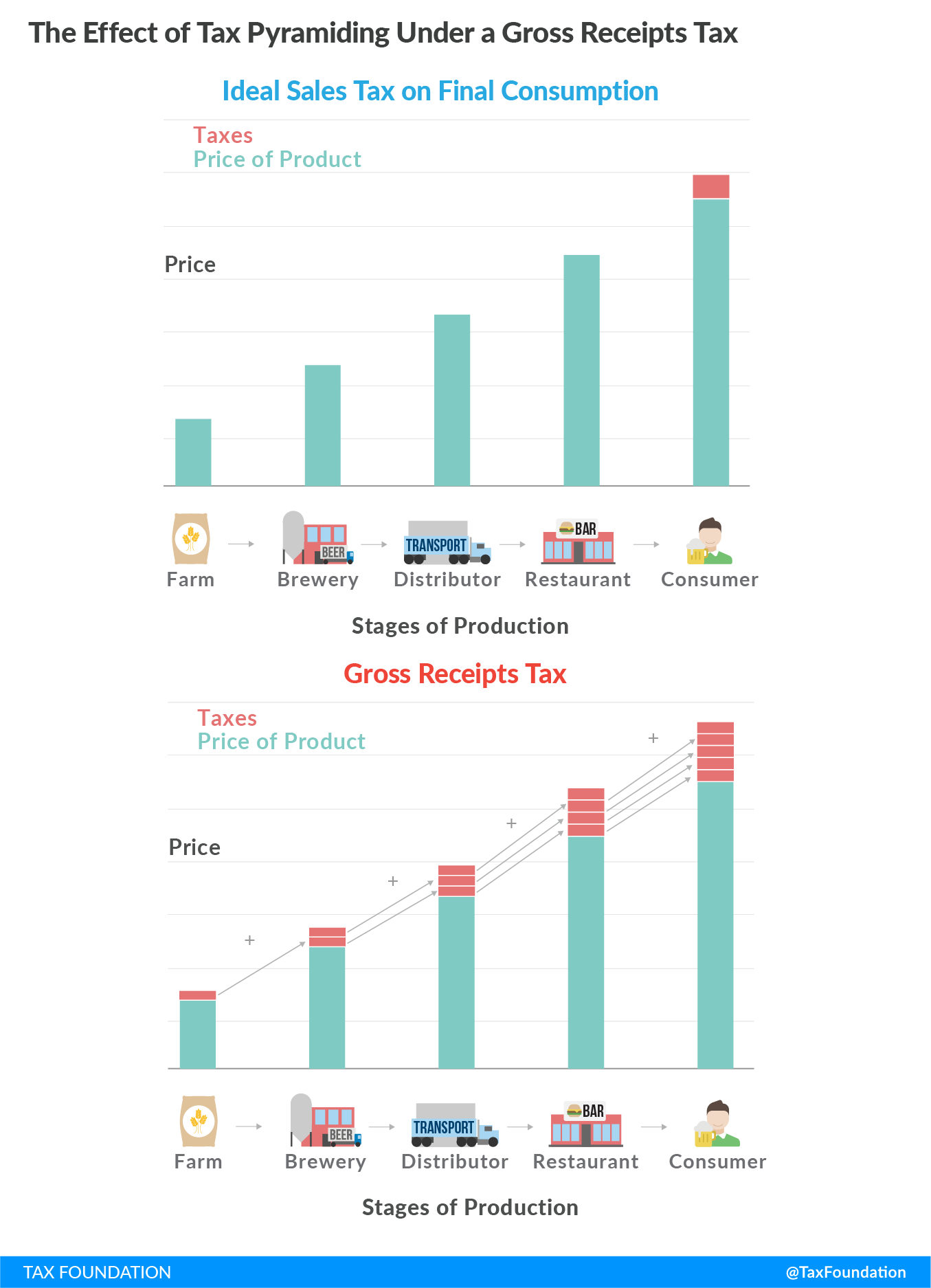Reduction and elimination of corporate income taxes (CIT) and the economic result: Examples from North Carolina and Ohio
The corporate income taxA corporate income tax (CIT) is levied by federal and state governments on business profits. Many companies are not subject to the CIT because they are taxed as pass-through businesses, with income reportable under the individual income tax. (CIT) is levied by federal and state governments on business profits, which are revenues (what a business makes in sales) minus costs (the cost of doing business).
State-level corporate income taxA tax is a mandatory payment or charge collected by local, state, and national governments from individuals or businesses to cover the costs of general government services, goods, and activities. rates vary across the country. Six states (Nevada, Ohio, South Dakota, Texas, Washington, and Wyoming) levy no corporate income tax, while the remaining states and the District of Columbia do tax corporate profits.
Note: Many companies are not subject to the CIT because they are taxed as pass-through businesses, with income reportable under the individual income taxAn individual income tax (or personal income tax) is levied on the wages, salaries, investments, or other forms of income an individual or household earns. The U.S. imposes a progressive income tax where rates increase with income. The Federal Income Tax was established in 1913 with the ratification of the 16th Amendment. Though barely 100 years old, individual income taxes are the largest source of tax revenue in the U.S. .
Lowering the CIT: North Carolina
North Carolina’s tax environment is one of the nation’s most competitive. As of 2021, the state boasted the nation’s third-lowest effective tax rates for newly established firms and fifth-lowest rates for mature firms.
Just eight years ago, North Carolina had the highest statutory corporate income tax rate in the Southeast. Today, North Carolina’s corporate income tax rate is the nation’s lowest at 2.5 percent. The corporate tax rate was cut from 6.9 percent to 6 percent in year one, with further reductions to 3 percent, subject to meeting revenue targets, implemented through 2017. Subsequently, the legislature chose to lower the rate even further, to 2.5 percent.
With the reduction of the CIT over seven years came a broadening of the state sales taxA sales tax is levied on retail sales of goods and services and, ideally, should apply to all final consumption with few exemptions. Many governments exempt goods like groceries; base broadening, such as including groceries, could keep rates lower. A sales tax should exempt business-to-business transactions which, when taxed, cause tax pyramiding. base, while the individual income tax and franchise tax were both reduced.
Overall, state tax collections per capita are lower than 32 other states, at $2,795, but state revenues per capita are also some of the lowest, at $5,675.
| Simplicity | ✔️ |
| Transparency | ✔️ |
| Neutrality | ✔️ |
| Stability | ✔️ |
North Carolina is in a competitive region, and, as of 2021, now ranks 10th for overall state business tax competitiveness and 4th for corporate tax competitiveness.
Following these reforms, North Carolina has enjoyed stronger GDP, higher in-migration rates, and a better business climate.
The state has a bill awaiting further consideration that would gradually reduce the corporate income tax to zero percent by 2027 while making reforms to the state’s franchise (capital stock) tax, the least competitive remaining component of the state’s tax code. The legislation would make North Carolina the third state to forgo both a CIT and a gross receipts taxA gross receipts tax, also known as a turnover tax, is applied to a company’s gross sales, without deductions for a firm’s business expenses, like costs of goods sold and compensation. Unlike a sales tax, a gross receipts tax is assessed on businesses and apply to business-to-business transactions in addition to final consumer purchases, leading to tax pyramiding. .
Eliminating the CIT: Ohio
Ohio’s 2005 tax reform package included provisions to make Ohio’s business climate more economically competitive and incentivize business investment in the state.
An important part of this package was the elimination of Ohio’s corporate income tax, which was phased out by 2009. The tax was phased out in annual reductions of 20 percent, until no liability remained. The legislation also eliminated a capital stock tax (on business net worth) and the property taxA property tax is primarily levied on immovable property like land and buildings, as well as on tangible personal property that is movable, like vehicles and equipment. Property taxes are the single largest source of state and local revenue in the U.S. and help fund schools, roads, police, and other services. on business machinery and equipment, in addition to making changes to individual income and sales taxes.
Ohio is the only state to repeal a corporate income tax to date, but it did so by replacing it with a gross receipts tax (GRT), called the Commercial Activity Tax (CAT). GRTs provide a relative advantage to large and profitable businesses but can be harmful to others. GRTs result in tax pyramidingTax pyramiding occurs when the same final good or service is taxed multiple times along the production process. This yields vastly different effective tax rates depending on the length of the supply chain and disproportionately harms low-margin firms. Gross receipts taxes are a prime example of tax pyramiding in action. , where the same tax is imposed multiple times on the final product, and tax businesses regardless of profitability or profit margins.
While CITs only tax net income and provide loss carryforward provisions to smooth payments over the business cycle, the CAT does not differentiate between profitable and unprofitable businesses.
Whereas North Carolina saw a significant increase in in-migration following its reforms, Ohio’s tax changes have failed to stem the tide of outmigration, with the state losing residents and continuing to have one of the worst business climates in the nation despite the legislation representing a net tax reduction and containing the elimination of several highly uncompetitive taxes, particularly the capital stock tax.
| Simplicity | ✔️ |
| Transparency | ❌ |
| Neutrality | ❌ |
| Stability | ✔️ |
Further Reading
Below are some resources regarding the reduction and elimination of the CIT from Tax Foundation and other sources. Please conduct additional research on the case prior to discussion.
- State Corporate Income Tax Rates and Brackets for 2021
- 2021 State Business Tax Climate Index
- North Carolina’s Tax Competitiveness
- North Carolina Tax Reform Options: A Guide to Fair, Simple, Pro-Growth Reform
- Ohio’s Commercial Activity Tax: A Reappraisal
Ohio Tax and Revenue Structure
Reflect on the following questions:
- What is the problem(s) being addressed in each state?
- How do these policies meet (or not meet) the Principles of Sound Tax Policy?
- What general options are available to develop more sound policy?
- Who are the stakeholders and what are their interests?
- How has this been addressed in other states?


